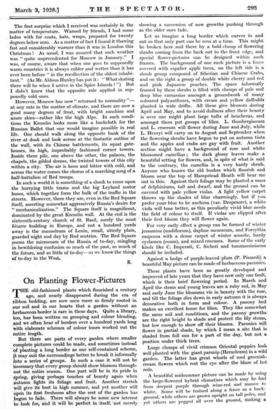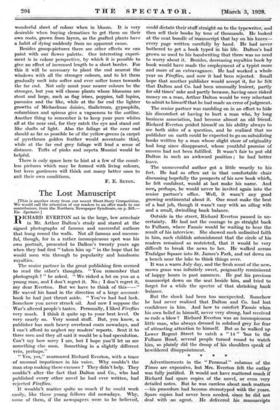On Planting Flower-Pictures
THE old-fashioned plants which flourished a century ago, and nearly disappeared during the era of ribbon bedding, are now once more so firmly rooted in our soil and in our hearts that a garden without an herbaceous border is rare in. these days. Quite a library, too, has been written on grouping and colour blending, and we often hear of borders over a hundred yards long With -elaborate schemes of colour tones worked Out the entire length.
But there are parts of every garden where smaller complete pictures could be made, and sometimes instead —of planting a long boider as One 'self-contained scheme, may suit the surrounclingi better to break it informally into a series of groups. In such a case it will not be necessary that every group 'should show bloisom through- out the entire season. One part will be in its pride in Spring, giving perhaps touches of beauty again when autumn' lights its foliage and fruit. Another stretch will give its best in high suminei, and yet another will ,Open its first freshness after the rest of the garden has pegun to fade. There will alWayi be some new interest to look for, and- it will be perfect in -itself, 'not- merely showing a succession of new growths pushing through as the older ones fade.
Let us imagine a long border which curves in and out so that only part can be seen at a time. This might be broken here and there by a bold clump of flowering shrubs coming from the back out to the front edge, and special flower-pictures can be designed within such frames. The background of one such picture is a fence covered with espalier apple trees, on the left side is -a shrub group composed of Siberian and Chinese Crabs, and on the right a group of double white cherry and red and pink Japanese peaches. The space informally framed by these shrubs is filled with clumps of pale and deep blue camassias amongst a groundwork of many coloured polyanthuses, with cream and yellow daffodils planted in wide drifts. All these give blossom during April and May, and to avoid dullness after their beauty is over one might plant large tufts of heucheras, and amongst them put groups of lilies. L. thunbergianum and L. croceum will flower during June and July, while L. Henryi will carry on to August and September when the flowering shrubs have begun to put on autumn tints and the apples and crabs are gay with fruit. Another section might have a background of rose and white blossomed camellias ; the dark glossy leaves .make a beautiful setting for flowers, and, in spite of what is said to the contrary, the camellia is a very hardy shrub. Anyone who knows the old bushes which flourish and bloom near the top of Hampstead Heath will bear me out in this. Against their foliage may be planted a mass of delphiniums, tall and dwarf, and the ground can be covered with pale yellow violas. A light yellow carpet throws up the shades of blue charmingly, but if you prefer your blue to be anchusa (var. Dropmore), a white viola will tone better, as this peculiarly vivid blue needs the field of colour to itself. If violas are clipped after, their first bloOrn they will flower again.
For very early effect a group can be formed of winter jessamine (nudiflorum), daphne mezereum, and Forsythia suspensa with a dense carpet of winter aconite, hardy cyclamen (coum), and mixed crocuses. Some of the early kinds like C. Imperati, C. Sieberi and tommassinianus should be included.
Against a hedge of purple-leaved plum (P. Pissardi) a beautiful May picture can be made of herbaceous paeonies.
These plants have been so greatly developed and improved of late years that they have now only one fault, which is their brief flowering period. In March and April the stems and young leaves are, a ruby red, in May and early June the blossoms vie in beauty with the rose, and till the foliage dies down in early autumn it is always decorative both in form and colour. A paeony bed makes an excellent home for lilies. They like somewhat the same soil and conditions, and the paeony growths are the right height to shade and protect the lily stems, but low enough to show off their blooms. Paeonies will flower in partial shade, by which I mean a site that is shaded from full sun for a part of the day, but not . a position under thick trees.
Large clumps of vivid crimson Oriental poppies look well planted with the giant parsnip (Heracleum) in a wild garden. The latter has great whorls of cool greenish- cream flowers which rest the eye after the blaze of hot reds..
A A beautiful midsummer picture can be made by using the large-flowered hybrid clematises which may be had from deepest purple through wine-red and mauve to white. Some will be trained along a fence as a back- ground, while others are grown upright on tall poles, and yet otters are pegged all over the ground, making a wonderful sheet of colour when in bloom. It is very desirable when buying clematises to get them on their own roots, grown from layers, as the grafted plants have a habit of dying suddenly from no apparent cause.
Besides group-pictures there are other effects we can paint with our flower palette. One interesting experi- ment is in colour perspective, by which it is possible to give an effect of increased length to a short border. For this it will be necessary to plant the end nearest the windows with all the stronger colours, and to let them gradually melt into softer and ever softer tones towards the far end. Not only must your nearer colours be the stronger, but you will choose plants whose blossoms are stout and large, such as flag irises, poppies, tall lupins, paeonies and the like, while at the far end the lighter growths of Michaehnas daisies, thalictrum, gypsophila, columbines and spireas give a vagueness to the outline. Another thing to remember is to keep your pure whites all at the near end, for they catch the eye and stand out like shafts of light. Also the foliage at the near end should as far as possible be of the yellow-greens (a carpet of pyrethrum golden feather would accentuate this), while at the far end grey foliage will lend a sense of distance. Tufts of pinks and nepeta Mussini would be helpful.
There is only space here to hint at a few of the count- less pictures which may be formed with living colours, but keen gardeners will think out many better ones to suit their own conditions.
F. E. SETON.































































 Previous page
Previous page